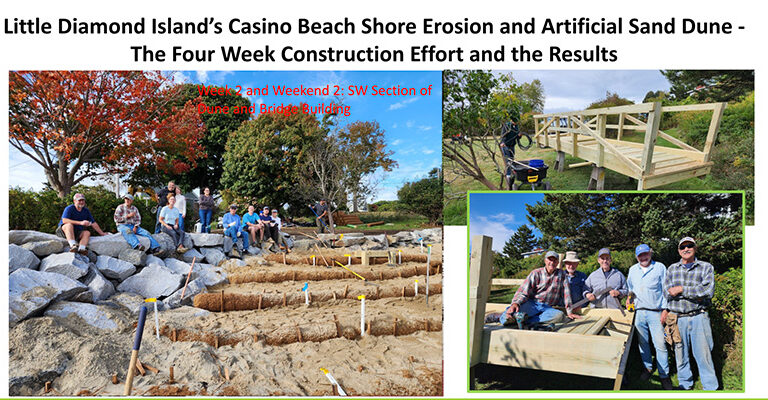Some tiny bottom-dwelling organisms may have to be sacrificed for the health of a Penobscot River cove.
But because these critters play an important role in the ecosystem, scientists hope to observe a temporary decline in their population along the intertidal flats of Orrington’s East Cove 3 when permits are approved for the deposit of 4-6 inches of clean sand over several acres of mercury-contaminated sediment there.
Industrial mercury has discharged into the estuary since 1967, when the Orrington-based HoltraChem Manufacturing Company began releasing the toxin into the air and the Penobscot River. Later studies estimated that 6-12 tons of the element were sent downstream through 1972. The deluge threatens the area to this day.
“[Mercury] is considered a persistent contaminant because it doesn’t break down easily in the environment,” said Lauri Gorton, program manager of the Greenfield Penobscot Estuary Remediation Trust. In a March presentation hosted by the University of Maine’s Mitchell Center for Sustainability Solutions, Gorton noted that when mercury does get broken down by aquatic bacteria and other environmental factors, the process converts it to methylmercury, which is even more toxic.
Compounding mercury’s environmental persistence is its high density, which helps bind it to sediment. In the lower Penobscot, mercury that’s bound to the sentiment is also stalled by powerful tidal action.
The Penobscot’s varied hydrodynamics are one example of the many natural processes that the remediation Trust must account for in its consideration of the most beneficial ways to put a $187 million environmental settlement to work in healing the estuary.
“One of the things that we want to be able to do with this pilot is demonstrate that the [strategies] that have been successful in other places will be successful here,”
The settlement, and its accompanying framework for remediation, were outlined in a consent decree submitted to the U.S. District Court for Maine by the Maine People’s Alliance, the Natural Resources Defense Council, and Mallinckrodt U.S. LLC in 2021. The decree came more than two decades after the MPA and NRDC first filed suit against Mallinckrodt, which owned and operated the HoltraChem facility from 1967 to 1982.
In the claim, the plaintiffs asserted that mercury-contaminated air emissions and river-bound wastewater, released by the plant under Mallinckrodt’s ownership, “have contaminated the lower Penobscot River, creating an imminent and substantial endangerment to the health and environment.”
After the suit was filed, a court-appointed scientific panel conducted a two-phase study from 2005 to 2013 that confirmed the presence of such a threat. Among their findings were elevated mercury levels in crab and lobster tissue from specimens harvested in the lower river, and in 2014, those results prompted the state to permanently close fishing in 7 square miles in the area. In 2016, the closure was expanded further.
The consent decree was approved by the court in 2022 and requires Mallinckrodt to fund not only $187 million in mercury remediation measures to accelerate recovery, long-term contamination monitoring, and beneficial projects, but also a potential additional $80 million for contingencies.
As an approved custodian of those funds, the Greenfield Penobscot Estuary Remediation Trust’s responsibilities include the investigation, outreach, planning, and execution phases of the remediation effort.
If permits are approved, that effort may begin as soon as September with a small pilot project that will blanket six acres of Orrington Reach’s East Cove 3 with pristine sand in a process called thin-layer capping, or TLC. The cap, which is composed of several inches of pristine sand, will serve as a buffer between the external environment and the toxic sediment below.
The cap is also expected to have a short-term negative effect on the benthic polychaete population living below it, and that outcome is entirely by design. The small, segmented worms and other sediment-dwelling invertebrates have the dubious privilege of making an ideal meal for a wide array of estuary residents including lobster, crabs, sturgeon, salmon, bass, and a host of shorebirds.
“We consider them the bottom of the food chain, if you will,” said Gorton.
However, their role as a fundamental source of nutrition poses a problem when they also serve as a vehicle for mercury transfer throughout the estuary.
“Once mercury gets into the sediment, the organisms that live and eat in that sediment start to pick it up,” Gorton said. “As fish and birds eat these organisms, they also pick up mercury, and when more predators, like eagles and people, [consume] those fish and birds, the mercury continues to make its way up the food chain.”
The cap will cut off the benthic organisms below it from food and oxygen. As their population dwindles, predators will be forced to look elsewhere for food—until the time comes, perhaps as soon as 12-18 months later, when river’s tidal action introduces invertebrates to the clean cap which can establish Themseves and start feeding the locals once more.
A successful TLC pilot will have significant implications for the scope and scalability of additional capping efforts throughout Orrington Reach. But success will depend on many factors, including the cap’s stability over time, and the results of follow-up mercury monitoring on nearby wildlife.
Gorton, for one, is optimistic.
“One of the things that we want to be able to do with this pilot is demonstrate that the [strategies] that have been successful in other places will be successful here,” she said.
The Trust’s approach, Gorton indicated, now and in the future, will be thoughtful and methodical, as capping and other remediation options like dredging and sediment removal are explored. She also clarified that there is no room for untested experimentation.
“The funds that are provided within the consent decree, although very significant, are not enough to completely clean up the estuary,” she said. “So our goal is to put it to best use, by focusing on these two things: reducing exposure to mercury, and then accelerating the recovery of the estuary.”
Informing that goal, Gorton said, are those who must benefit the most from remediation.
“The court made it very clear that the ultimate beneficiary is the river [and] the residents: the people that enjoy the river and the flora and fauna,” she said. “Everyone working on this takes that to heart. We have an opportunity to help create a legacy for generations of people that really value the river, and I can understand why. It’s spectacular.”





